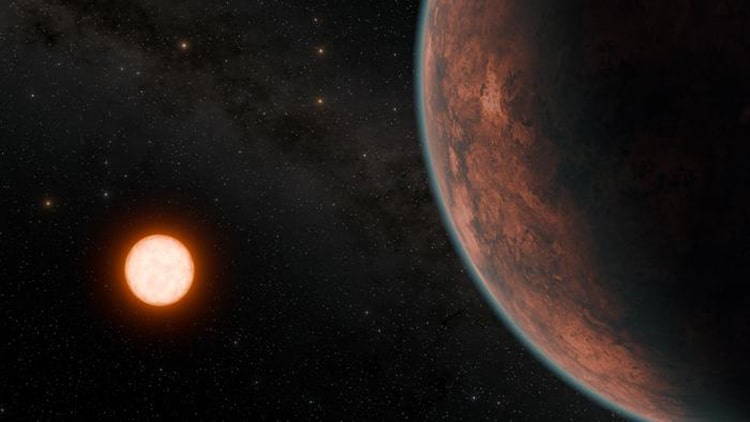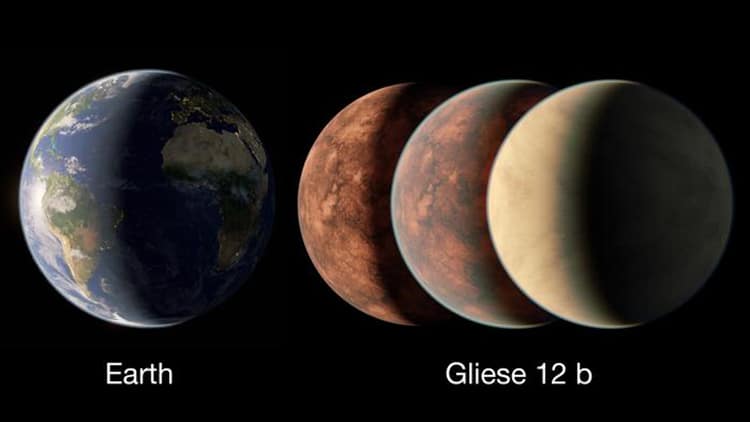
An artist’s concept of Gliese 12 b with a thin atmosphere and it’s red dwarf in the distance. (Photo: NASA/JPL-Caltech/R. Hurt (Caltech-IPAC))
The search for extraterrestrial life has long motivated astronomers. The universe is vast and many realms still remain unknown. Thankfully, the evolving technology of astronomers at NASA and other research centers has shed light on increasingly far reaches of the skies. Observations from NASA’s Transiting Exoplanet Survey Satellite (TESS) have recently revealed yet another exoplanet—a planet beyond our Solar System.
This exoplanet, known as Gliese 12 b, is fascinating because it is the most promising exoplanet discovered in terms of potential habitability. More information is needed, but the exciting find announced in Monthly Notices of the Royal Astronomical Society is already turning astronomical heads.
Gliese 12 b is about 40 light-years from Earth. It orbits a star named Gliese 12, a red dwarf much cooler than our own Sun. The exoplanet makes a complete orbit in a swift 12.8 days unlike our Earth’s year-long journey. However, Gliese 12 b is quite close in size to Earth, about the size of Venus which is slightly smaller than our own planet.
Gliese 12 b being much closer to its own duller sun means it gets 1.6 times the radiation than Earth does. Estimates place the surface temperature at about 107 degrees Fahrenheit at the exoplanet’s surface. While significantly hotter than Earth, this estimate could be affected by the exoplanet’s atmosphere—if it has one. Within the habitable zone of distance from its star, further investigation may reveal a planet that can sustain liquid water, and maybe life.
Scientists hope to use the James Webb Space Telescope to peer closer at the exoplanet and search for signs of an atmosphere. According to a statement, “Getting an answer is vital because it would reveal if Gliese 12 b can maintain temperatures suitable for liquid water—and possibly life—to exist on its surface, while also unlocking answers about how and why Earth and Venus evolved so differently.” Venus’ atmosphere amps up its heat to unbearable temperatures, while our atmosphere maintains the conditions for water and life.
Larissa Palethorpe, an author of the study, commented, “It is thought that Earth’s and Venus’ first atmospheres were stripped away and then replenished by volcanic outgassing and bombardments from residual material in the solar system. The Earth is habitable, but Venus is not due to its complete loss of water. Because Gliese 12 b is between Earth and Venus in temperature, its atmosphere could teach us a lot about the habitability pathways planets take as they develop.”
The newly discovered exoplanet, Gliese 12 b, offers the best chance at discovering a habitable planet like Earth.

Earth with different possible Gliese 12b atmospheres which change the size. (Photo: NASA/JPL-Caltech/R. Hurt (Caltech-IPAC))
h/t: [Science Alert]
Related Articles:
Agriculture on Mars Is Closer to Reality Thanks To Mayan Farming Practices
Olympus Mons: The Largest Volcano in Our Solar System Is Located on Mars
James Webb Space Telescope Captures Earliest and Most Distant Galaxies Known by Scientists
Astrophotographer Captures Incredible Sunspot Close-Ups From His Backyard
